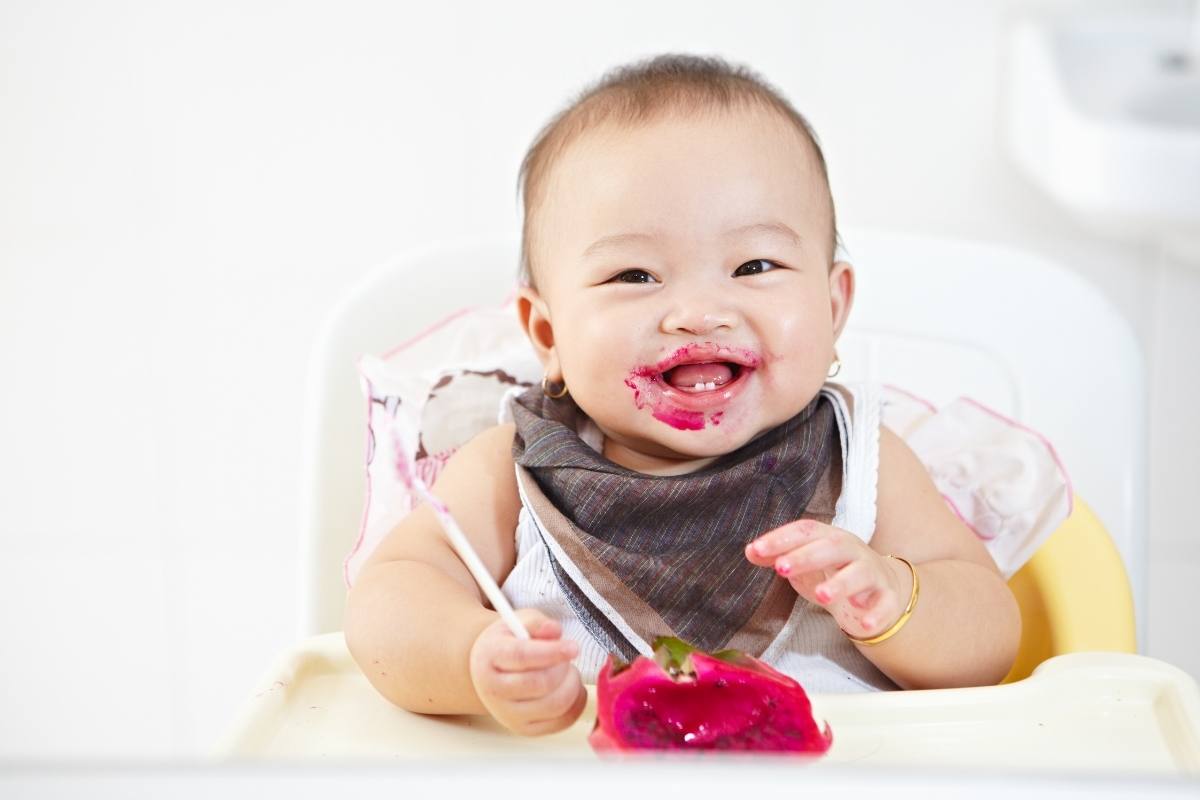Did you end up on this page after typing “dangers of baby led weaning” into that Google search bar? If so, you may have one word on your mind: CHOKING!
This is the number one fear parents express to us when starting babies on solids!
I have to admit, about a decade ago when parents first came to me (Jess) for my professional advice on baby led weaning, I was skeptical. Like, extremely skeptical! It seemed to me it was a dangerous fad based on unfounded beliefs about how babies learn to eat.
But, a lot has changed in the baby world during these past ten years! And I’m not just talking about trends: the research world has responded to this interest in baby led weaning by conducting some really good studies to examine the safety and nutritional adequacy of this feeding method!
I’ll get into some of the studies later, but the quick answer is that modified baby led weaning methods are just as safe as the traditional “start with spoon feeding purees” method and provides all the nutrition a baby starting solids needs!
Needless to say, I’m now a convert to the baby led weaning method!
What Is Baby Led Weaning?
If you haven’t heard about it, Baby Led Weaning is about giving babies control over their food. It’s about letting them play with food, figure out that it’s food, get it into their mouths on their own, and figure out how to swallow it. It’s letting babies self-feed from the very first bite.
To quote www.babyledweaning.com, “it’s ‘baby-led’ in the sense that you let them do what they need to do while they’re learning, and as the parent you resist the urge to get wound up in knots about how much they’re eating, whether they like the food you thought they’d like and whether it’s smushed into the nearest curtain. The main thing is… it’s all good clean (messy) fun.”
Sounds great, right?
HOWEVER, baby led weaning does need to be done safely.
Without further ado, here are our caveats surrounding the baby led weaning movement.
Baby Led Weaning Makes Some Parents Nervous
With all the hoopla and excitement of baby led weaning these days, some parents feel pressured to use this feeding method when they just don’t feel comfortable! We do our best to reassure parents and arm them with education that will make them feel comfortable and confident to offer their babies handheld foods. But at the end of the day, if someone is still really nervous, we want parents to know that it’s 100% acceptable to start with purees! You don’t want to stay at that stage too long but you can definitely start there! Starting solids is a big milestone! Spoon feeding purees can be the gentle introduction parents need.
Like I said earlier, the risk of choking used to be one of my major hesitations about baby led weaning. But research has shown that when it’s used safely and appropriately, offering baby handheld foods is not associated with a higher choking risk! If you’re nervous about choking, go get a free copy of our guide: The Top 5 Feeding Fears (and how to overcome them!)
Baby Led Weaning is Not Safe for All Babies
Babies need to be meeting certain developmental milestones and have the ability to safely move food around in the mouth. We want to set our babies up for success! Here are some scenarios where baby led weaning may not be the safest or best approach:
- Babies younger than 6 months
- Unresolved tongue or lip tie: babies need to be able to easily move food around in their mouth with their tongue.
- Cleft lip or palate: these can result in a unique physical structure of the mouth that can potentially make biting, chewing and swallowing a bit more challenging.
- Hypotonia: typically this is low muscle tone of the lips, tongue or jaw – when this happens it affects the ability to move oral structures which can in turn impact the ability to manage food in the mouth.
Baby Led Weaning May Lead to Baby not Getting Key Nutrients
Many Baby Led Weaning enthusiasts will tell you that your baby should eat what you are eating. It makes meals so much easier, your baby is motivated to eat what he sees you eating, etc. Sounds great!
The problem: babies have specific nutritional needs. You may not be eating meals that are tailored to a baby’s diet.
Babies over the age of 6 months need lots of iron. More than an adult man needs. More than breastmilk provides. Preventing iron deficiency is the main reason for starting solids between 4-6 months. I’ve spoken to many mothers who are implementing Baby Led Weaning with their children, who are not aware of this important nutritional need.
Some of the high-profile Baby Led Weaning people do highlight this need. This is great! Unfortunately, this information is not trickling down to everybody in the community. Just check out this discussion! The owner of that page, which has over 28,000 likes right now, says “No need for you to worry about iron… Just keep breastfeeding.”
That is just dangerous advice.
The good news is that you can benefit from the principles of Baby Led Weaning, while getting your infant enough iron.
Just make sure that all of your family meals incorporate a high-iron food, and feed your infant those foods specifically. Let’s say you whipped together some delicious burrito bowls for dinner that are made with black beans. The beans are a good source of iron, so setting some aside for baby is a great way to include her in what the family is eating AND focusing on her specific nutritional needs. That’s what we call a win-win!
It’s also important to add, we practice in Canada. And unlike in other countries, there is no routine supplementation of iron at 4 months – which does take place in other countries.
In this post, we teach you 6 steps for taking your own favourite meals and make them baby-friendly.
Baby Led Weaning May Lead to Baby Not Eating Enough Solid Foods
One mother told me that her baby didn’t eat any solids until 8 months, because he just didn’t get the food into his mouth.
Babies at six months are just beginning to learn how to grasp objects between their thumb and index fingers (called the pincer grasp), which enables them to get it into their mouths easily. Most babies aren’t accomplished at the pincer grasp until 9-12 months.
If your child has not developed the pincer grasp and you are not providing age and developmentally appropriate foods in the right size, shape, and texture, they will not be getting the nutrition they need.
Babies who haven’t developed their pincer grasp yet need to be offered foods they can grasp with their whole hands.
Check it out: our e-course Start Solids Confidently goes into great detail showing you how to prepare handheld foods in the right shape, size, and texture to match your baby’s motor skill development!
The Research Behind Baby Led Weaning Safety
Remember that research I was talking about earlier, showing no difference in choking events between babies fed a modified baby led weaning method and those who began with traditional spoon feeding?
This study surveyed caregivers regarding their method of feeding (BLW or traditional), whether their baby had ever choked, and if so, what texture of food (puree, lumpy, or finger food) did baby choke on. There was no statistical difference in rates of choking between the feeding methods!
Then this major landmark study, nicknamed the B.L.I.S.S. study, divided babies into two groups: traditional or BLW method. They provided caregivers in the baby led weaning group with education on serving foods that baby could self-feed that did not pose as choking hazards.
Again, there was no statistical difference in choking between the two groups!
But, just like the authors of this study, we recognize it’s important for caregivers to understand how to prepare food safely for baby to self-feed. That’s one of the main reasons why we created the Start Solids Confidently E-course. In our e-course we provide detailed instructions on how to serve nearly every type of food to your baby safely: meats, plant-based proteins, grain products, veggies, fruit, etc!
Need more? Check out this blog post we wrote comparing BLW versus spoon feeding!






